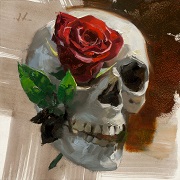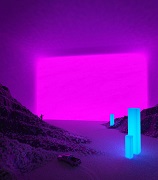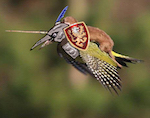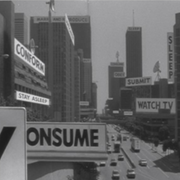|
got a good deal on a Pentax k70 and a 18-135mm weather resistance lens, hopefully this wasn't a terrible idea. wargames fucked around with this message at 19:02 on Sep 27, 2018 |
|
|
|

|
| # ? Apr 24, 2024 20:09 |
|
I am quite interested in whatever followup about your K70 you're willing to share. I spent a bit of procrastination time last week thinking about my next camera, I hadn't been lusting over gear for a while and it felt like that was missing from my life (also missing: disposable income. But I have much practice in ignoring such concerns). I've got a K-5 that I want to send for servicing because I've been using it (and thoroughly enjoying it) for a while. I dug into PentaxForums.com and figured out the K70 is most probably the appropriate successor for me, though the KS-2 was a decent second choice / lower-cost option. If I get off my rear end and actually seriously start considering a new-to-me camera, hearing about your experience would be very useful. In any case, enjoy! And post your pictures here in the Dorkroom, in whatever thread is appropriate.
|
|
|
|
Would be willing to answer questions, but this will be my first camera.
|
|
|
|
ExecuDork posted:I am quite interested in whatever followup about your K70 you're willing to share. I spent a bit of procrastination time last week thinking about my next camera, I hadn't been lusting over gear for a while and it felt like that was missing from my life (also missing: disposable income. But I have much practice in ignoring such concerns). I've got a K-5 that I want to send for servicing because I've been using it (and thoroughly enjoying it) for a while. I dug into PentaxForums.com and figured out the K70 is most probably the appropriate successor for me, though the KS-2 was a decent second choice / lower-cost option. K70 got, along with a 18-135mm and a 50 f1.8 I also did a day of shooting. https://www.flickr.com/photos/161241843@N06/albums/72157674201969738 with the ducks i tried to do some HDR, pixelshift, and bracketing photos, but really learned that i need a remote control for the camera, and i really like zoom lenses. edit Also wifi/app sucks pretty hard, and rarely connects for me. wargames fucked around with this message at 22:13 on Oct 6, 2018 |
|
|
|
I bought my first DSLR! It's a second hand Canon 700D. I also picked up a copy of Understanding Exposure. Now I've gotta go learn how to use this and shoot things.
|
|
|
|
cptn_dr posted:I bought my first DSLR! It's a second hand Canon 700D. I also picked up a copy of Understanding Exposure. Congrats - thatís a great book to start with. After you get to shooting post in the photo a day thread - itís not that active anymore but it will make you learn to critique others as well as get critiques. Did you get any lenses yet?
|
|
|
|
I'm borrowing a 40mm from my Dad, and it came with an 18-55mm kit lens as well, which is... fine. I like the 40 a lot, though.
|
|
|
|
Cool, thatís good that you have a prime to start with. You might have heard this already but a good idea for new photographers with a kit lens is to go out and stick to 18, 24 and 35mm, treating it like a prime and not zooming at all. They are equivalent to roughly 28, 35 and 50mm focal lengths and it will give you an idea of which might serve you best when you branch out and get a prime in the future since they all excel at different things.
|
|
|
|
wargames posted:K70 got, along with a 18-135mm and a 50 f1.8 I also did a day of shooting. Good stuff. Keep shooting, keep posting pics, have fun. Sooner or later I'll think of a question for you.
|
|
|
|
ExecuDork posted:Good stuff. Keep shooting, keep posting pics, have fun. Planning on it. The 50mm 1.8f prime is nice but i dislike how far back i am when i take pictures. this might just me being a new to picture taking with a fancy camera.
|
|
|
|
wargames posted:Planning on it. The 50mm 1.8f prime is nice but i dislike how far back i am when i take pictures. this might just me being a new to picture taking with a fancy camera. Then you might want to get the 35mm (really a 53mm) prime. Still super fast, and you don't have to step as far back. I've got both on a K-p, which I got instead of the K-70. And the app is also pretty poo poo on that body, more often than not I just revert back to eye-fi/keenai.
|
|
|
|
I love 50mm on a crop body, it makes a really nice, fast short portrait lens. I had both the 35mm and the 50mm primes for my Nikon before I replaced the 35mm with an 18-35mm f/1.8, and the 50mm with a 50-150mm. I found the 35mm to be the top end of what I wanted in a wide angle shot (which makes sense as it's essentially a 'normal' lens on crop), and the 50mm fits nicely at the lower end of the portrait range for me. Having the 18-135mm will give you a good sense of where you like shooting, then get a higher quality lens down the line that matches that (or exceeds that if 135mm is coming up short).
|
|
|
|
I find the 135mm side of the kit lens to be nice enough, here is an example the th 18mm and the 135mm. _IMG2001 by war games, on Flickr _IMG2001 by war games, on Flickr _IMG2002 by war games, on Flickr _IMG2002 by war games, on Flickr
|
|
|
|
Yeah, looks like it's got some nice center sharpness.
|
|
|
|
Yeah, kit lenses these days can be great and even when you have expensive lenses to hand itís never a bad thing to have one still. Main difference youíll notice is stuff like one end being better than the other, variable and slow aperture, and build quality. Fast and fixed apertures is where zooms get expensive as theyíre complicated, and why people will suggest a widely used and affordable prime at 1.8, so you can get a taste of that life without spending a huge amount of money.
|
|
|
|
tribbledirigible posted:the 35mm (really a 53mm) A prime lens with a 35mm focal length ALWAYS has a focal length of 35mm. It never changes, you can put that lens on a "full-frame" camera, a DSLR with an APS-C sensor, or stick it with duct-tape to your phone with its teeny-tiny sensor. Still a 35mm lens. The comparison to "full-frame" is not technically incorrect, but it is pointless and just confusing for anybody (i.e. most people) who did not spend several years shooting 35mm film on a non-digitial SLR. I *did* spend several years shooting almost exclusively on 35mm film on my Minolta X-700, and a bunch of other people in here did something similar, but that 35-is-really-53 nonsense is totally useless for somebody without that muscle-memory history of squashing a piece of 70's or 80's magnesium against their nose. Terms like "normal" and "wide" apply to the field of view, which yes changes with sensor size ('crop factor') and focal length. But again, the comparison back to the gold standard of "full-frame" is as pointless and confusing as if the usual comparison was to field-of-view for a given focal length on your great-grandfather's wooden-box 8x10.
|
|
|
|
ExecuDork posted:Please don't do this. It is not at all helpful to keep stirring up this confusion regarding focal lengths. I know what you mean and agree with a lot of it. I think the language of ďreally a 53mmĒ is confusing because as you said, it is still a 35. But what is valuable to realize for newcomers is the equivalency because when they hear ď35mm is great for streetĒ and then they try one and find it isnít working for them and isnít matching up with images they see from others who say they are using a 35mm for street it will get confusing. Multiplying by 1.5 isnít that hard and although it isnít magically turning into another kind of lens it will give an equivalent field of view so if they are going to see people talk about 85mm being good for portraits, 35mm being good for street and so on then it is good to know what they can do on their camera to see similar results. But without experience shooting 35mm film or full frame I do think itís almost impossible to really see whatís happening and thatís why you hear explanations like ďx lens is really y lens on a crop sensorĒ. Same with aperture.
|
|
|
|
Yeah, getting your head around APSC to full frame equivalents is definitely one of those things you need to read a million times (ensuring you don't read misinformation, of which there is a ton) just to make sure you have it down right in your head. And I agree that at the end of the day, if you're only using the gear at hand... it doesn't really matter all that much, but comes in useful when branching out or reading up on things. The labeling on lenses is never going to change, and it does mean something even if it's not directly relevant to the hardware in your hands. The worst are people who say "I have a lens designed specifically for a crop sensor, so the 50mm marking actually refers to 50mm on APSC!" who then get a nasty surprise when they put a different 50mm on their camera just to find out it's identical. Thanks for spreading bad info, dipshits. I am a big proponent of APSC designed lenses, though. The focal ranges match the equivalents of normal lenses on full frame and there's generally good reason those ranges are used in the first place. I always crave the extra wide angle that FF designed lenses just don't give you that the crop ones account for. Hence I have an 18-35mm and a 50-150mm rather than a 24-70mm and a 70-200mm.
|
|
|
|
EL BROMANCE posted:there's generally good reason those ranges are used in the first place. Paper sizes, film formats, and digital camera sensor sizes illustrate this well. A long time ago, like before World War II, professional photogs shot on a narrow range of cameras that used a fairly restricted range of film formats (or glass plates). What we today call "large format" perfectly match the paper sizes that result from direct-contact printing, where there is no magnification of the film image. That's why picture frames are readily available in 8x10 and 5x4 inches even though nearly all consumer cameras (and many professional cameras) in the past 50 years have shot film or used digital sensors with dimensional ratios not equal to 5:4. "35mm" film is named that because that's the full width of the strip of film including sprocket holes; the actual image size is 24x36mm, a ratio of 3x4. "Full-frame" digital sensors have a wafer of silicate that's equal to that size, and various other digital formats are different sizes but quite often the same ratio - APC-C is smaller but also 3x4, for example. But it's bloody difficult to find a picture frame in that ratio; I'm personally fond of printing my photos at 8x12 inches, though I can only find a single brand and style of frames for that (without matting). I don't know but I suspect that way back in the early days of 35mm film, the 1950's and 1960's as many professionals switched from large- and medium-format cameras to 35mm SLRs, lens designers made decisions that resulted in a bag of primes consisting of 28/35/50/85/105mm (with some tweaks, like 55mm). Those decisions might have been based on ease of setting up a production line at a factory for creating and assembling parts that go into making a 28/2.8 or a 50/1.7. Factors that would have been important to those decisions, like factory down-time while re-tooling, are completely irrelevant today but nobody has broken away from old habits - why 28/2.8 and not 25/2.5? Or 75/1.7 instead of 85/1.7? The one exception I know of is the move from 105mm to 100mm for long macro lenses, showing there's not some major optical or mechanical barrier to that kind of change. The field of view at 28mm on a 35mm SLR is "wide"; smaller focal lengths are "very wide" or "ultra wide", but how different is 25mm, really? It's noticeably wider, yes. So why did the old lens designers not produce lenses in 25/35/45/55mm ? Why 70-210 (or 70-200, or 80-200) for everybody's favourite tele-zoom, and not, say, 100-250 from the beginning?
|
|
|
|
ExecuDork posted:I don't know but I suspect that way back in the early days of 35mm film, the 1950's and 1960's as many professionals switched from large- and medium-format cameras to 35mm SLRs, lens designers made decisions that resulted in a bag of primes consisting of 28/35/50/85/105mm (with some tweaks, like 55mm). Those decisions might have been based on ease of setting up a production line at a factory for creating and assembling parts that go into making a 28/2.8 or a 50/1.7. Factors that would have been important to those decisions, like factory down-time while re-tooling, are completely irrelevant today but nobody has broken away from old habits - why 28/2.8 and not 25/2.5? Or 75/1.7 instead of 85/1.7? The one exception I know of is the move from 105mm to 100mm for long macro lenses, showing there's not some major optical or mechanical barrier to that kind of change. I am far from an expert, and am still trying to fully grasp the significance of the actual focal length measurement, but this made me curious because I assume there is some actual thought behind this stuff. After digging through wikipedia, it appears it is based on math. https://en.wikipedia.org/wiki/Focal_length#In_photography posted:Camera lens focal lengths are usually specified in millimetres (mm), but some older lenses are marked in centimetres (cm) or inches. https://en.wikipedia.org/wiki/Normal_lens#The_image_circle posted:A normal lens typically has an angle of view that is close to one radian (~57.296˚) of the optical system's image circle.[citation needed] For 135 format (24 x 36 mm), with an escribed image circle diameter equal to the diagonal of the frame (43.266 mm), the focal length that has an angle of one radian of the escribed circle is 39.6 mm; the focal length that has an angle of one radian of the horizontally-bound inscribed image circle, is 33 mm; the focal length that has an angle of one radian of the vertically-bound inscribed circle, is 22 mm. This correlates with the popularity of 35 and 24 mm lenses, and the existence of 40 mm lenses, albeit the latter in a more restrained offer. A 50 mm lens has a vertical-bound inscribed circle angle of view of ~0.5 radians. A 70 mm focal length (typically only available in zoom lenses) has a horizontally-bound inscribed circle angle of view of ~0.5 radians. An 85 mm lens has an escribed (frame diagonal) circle angle of view of ~0.5 radians. Effectively, the 24, 35 and 40 mm trio have a 1:2 relation to the 50, 70 and 85 trio of focal lengths. "Normal" lenses, those that cover one radian in at least one of their inscribed or escribed image circles, belong to the first group, with 35 and 40 mm lenses closer to one radian than 50mm lenses. These Wikipedia articles seem a bit like academese, at least to me right now, so I think I sort of get what they're saying, but I don't really feel like taking the time right now to really parse the whole thing. Either way, it's kind of cool. I guess the TL;DR is the common lens focal lengths result in a field of view very close to 0.5 radians or 1 radian (across the vertical, horizontal, or diagonal axis depending on the focal length) on 35mm film/sensors.
|
|
|
|
ExecuDork posted:A prime lens with a 35mm focal length ALWAYS has a focal length of 35mm. There are some more wrenches to throw in towards understanding focal length and field of view. Lens focal lengths are only nominal. Many 50mm lenses are closer to 52mm, many 300mm lenses are actually shorter than 300mm. In practice this rarely matters, but there will be a slight difference when comparing lenses of the same focal length from different manufacturers. The marked focal length is the property of the lens when focused to infinity. The field of view and effective focal length will change when the lens is not focused to infinity. This is more of a problem with lenses that use internal focus and have fixed front elements. As an extreme example the Nikon 70-200 VR2 F2.8 when close focused at 200mm marked on the lens is actually about a 125mm focal length.
|
|
|
|
ExecuDork posted:"35mm" film is named that because that's the full width of the strip of film including sprocket holes; the actual image size is 24x36mm, a ratio of 3x4. "Full-frame" digital sensors have a wafer of silicate that's equal to that size, and various other digital formats are different sizes but quite often the same ratio - APC-C is smaller but also 3x4, for example. But it's bloody difficult to find a picture frame in that ratio; I'm personally fond of printing my photos at 8x12 inches, though I can only find a single brand and style of frames for that (without matting). You mean 3:2. 3:4 would be 24x32mm or 27x36mm.
|
|
|
|
pseudorandom posted:After digging through wikipedia, it appears it is based on math. lampey posted:There are some more wrenches to throw in towards understanding focal length and field of view. My main complaint was the "really 53mm" comment, because there's no way a 35mm lens magically transforms into a 53mm lens when attached to a different camera. But I hadn't realized the extent of variation in what appear to be fixed-focal-length lenses. Helen Highwater posted:You mean 3:2. 3:4 would be 24x32mm or 27x36mm. Whoops. Thanks for that.
|
|
|
|
The main trouble is people who look on a website or read a book and see lines like "35mm is an ideal length for landscape photography." So they put an expensive 35mm prime on their crop-sensor camera and realize, hey, these pictures look way more zoomed in than in the examples. And then the crushing blow comes. So folks will say stuff like "35mm (53mm equivalent)" to make it explicit that you have to do some extra math to match a particular Ansel Adams shot or whatever. For a beginner, the optical difference between a 35mm on a crop and a 50mm on a full-frame is extremely secondary to "dammit I can't get all this building in frame, this sucks."
|
|
|
|
When I have this discussion in the Dorkroom, I don't worry too much that people will misunderstand...except in the "My First DSLR" thread.
|
|
|
|
ExecuDork posted:Good stuff. Keep shooting, keep posting pics, have fun. Camera is a good excuse to get out of the house on the weekend. went to the oldest city in america. https://www.flickr.com/photos/161241843@N06/albums/72157672295796037 wargames fucked around with this message at 05:31 on Nov 18, 2018 |
|
|
|

|
| # ? Apr 24, 2024 20:09 |
|
double posting because progress happened just no new post here. So tonight was the night of lights for st augustine where they turn on the christmas lights and tree for the city. Know that it was going to be dark i took out the 50mm 1.8 and the 18mm-135mm. Well the 18-135 just couldn't suck in enough light without some noisy high iso pictures so here is an album of mostly 50mm prime pictures https://www.flickr.com/photos/161241843@N06/albums/72157703643197784/page1 I am super proud of this picture because this is America, a muslim family eating burgers and fries at a prirate themed pub, on the night the christmas tree gets lit up in a town founded by spanish conquistadors.  _IMG2412 by war games, on Flickr _IMG2412 by war games, on FlickrAlso video of an old granny getting down https://www.youtube.com/watch?v=nRsueLg6COo
|
|
|























